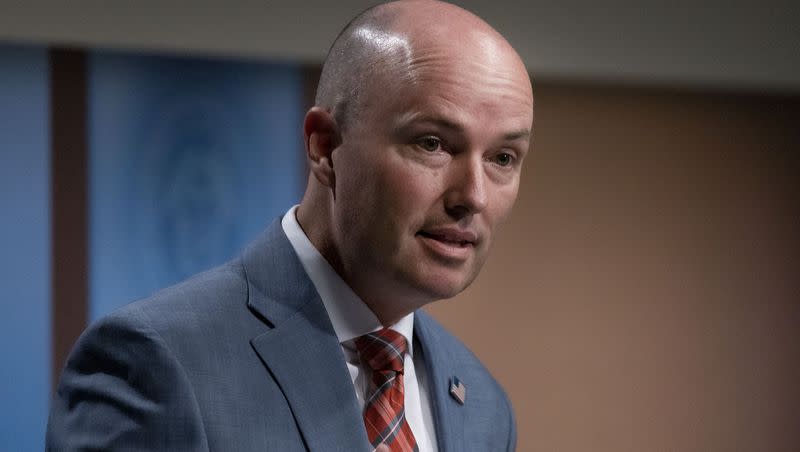Large national monuments are a ‘direct violation of the Antiquities Act,’ Gov. Cox says

Utah Gov. Spencer Cox has monuments on the mind.
Earlier this month, President Joe Biden designated a sweeping national monument in northern Arizona along the Utah border during his tour of Western states, which for Cox was “frustrating news.” Days later, the state’s lawsuit challenging the legality of Bears Ears National Monument was tossed out by a federal judge.
On Thursday during the monthly PBS Utah news conference, Cox called designations of that size a “direct violation of the Antiquities Act,” the statute Biden and presidents before him used to establish national monuments, telling reporters there’s a better way to protect land.
Related
Federal judge tosses Utah’s lawsuit over Bears Ears, Grand Staircase
What you need to know about the impact Arizona’s new national monument has on Utah
Cox’s concern is twofold — the monument status brings more people to the area, and the federal government lacks funding to handle the influx of visitation. And the protections hinder industry, especially mining for critical minerals that Cox says will help fight climate change.
“It has the exact opposite effect of what the president is intending to do,” Cox said. “There are parts of the land that absolutely need to be completely protected, and others that look just like random sagebrush with no artifacts there, and that happen to have some very critical minerals that are really important to decarbonizing our atmosphere.”
The new Baaj Nwaavjo I’tah Kukveni Grand Canyon National Monument spans roughly 917,000 acres in northern Arizona, bordering nearby Grand Staircase-Escalante National Monument in Kane County. To the east is Bears Ears National Monument, at over 1.3 million acres.
“The language is very clear that the monument must be the smallest size necessary to protect the artifacts, or the antiquities, that are at risk. And I don’t believe millions of acres does that at all. I think the average person would agree that a clear, plain reading of the statute does not match up with that,” Cox said.
But that’s not U.S. District Judge David Nuffer’s interpretation of the act, who recently tossed out the state’s lawsuit against the Bears Ears restoration. In his ruling, he wrote that the Antiquities Act grants discretionary authority to the U.S. president when it comes to monument designations.
The move was celebrated by tribal leaders and environmental activists. But just days later, Utah filed an appeal. The case will go to the 10th Circuit Court of Appeals, and Cox on Thursday said he believes it will end up in front of the U.S. Supreme Court.
Even though the high court has a conservative majority, Steve Bloch, the legal director for the conservation group Southern Utah Wilderness Alliance, said the appeal isn’t giving him any anxiety.
“For more than 100 years the federal courts have turned away every single attack challenging the size of a national monument,” Bloch said, calling the challenge a “garden variety case the courts have rejected every time.”
It’s not that the governor doesn’t want to protect areas like Bears Ears or the land around the Grand Canyon — “I share their desire to protect the land,” Cox said, speaking about the Native American tribes who lobbied for both national monuments. “Sadly, this does not do that.”
In addition to a lack of federal funding, Cox said he’s spoken with tribal members who voiced concern over the impact the monument status had on the area.
“I was told by Native Americans who wanted the monument designation, that more of the artifacts are being destroyed, more of the landscapes are being trampled on because people are coming from all over the country and all over the world to see this new monument,” Cox said. “There are other ways to protect those things.”
Bloch said that’s a common argument. In response to the governor’s remarks, he pointed to the broad tribal coalitions that ultimately support the protections.
“We frequently hear opponents of Bears Ears saying they have talked with a few individual members of one or more Native American tribes, and they try and leverage those statements into something that they’re not,” Bloch said. “I mean, the five sovereign nations that make up the Bears Ears Inter Tribal Coalition support the Bears Ears National Monument.”
“I’ll stick with what the tribal nations say about those places,” Bloch said.
What’s more, Cox said, is the strict environmental protections enforced by national monument status prevent mining for critical minerals used for renewable energy development and electric vehicle manufacturing. The governor on Thursday said the same people who want more climate-friendly technology also support sweeping land protections.
“You can’t say in one breath that you believe in climate change, that you’re desperate to have more electric vehicles, that we need to have better and more efficient and cleaner energy production — and then say we can’t mine any of the critical minerals that are necessary to do all of those things,” Cox said.
Bloch called that claim “categorically false.” Though there were uranium claims in Bears Ears before then-President Barack Obama issued the designation in 2016, he says when the protections were reduced under the Trump administration, there was no rush to mine critical minerals in the area.
“We’re not finding measurable significant amounts of rare minerals in the Grand Staircase or Bears Ears,” Bloch said, calling the argument a “red herring to try and generate a rationale for opposing the monument designations.”

